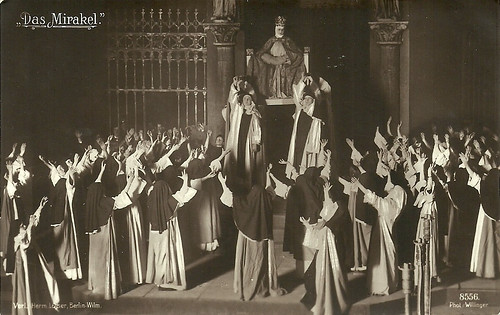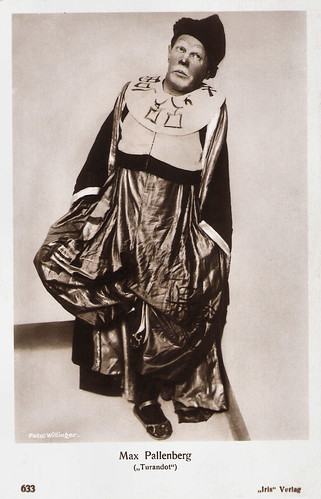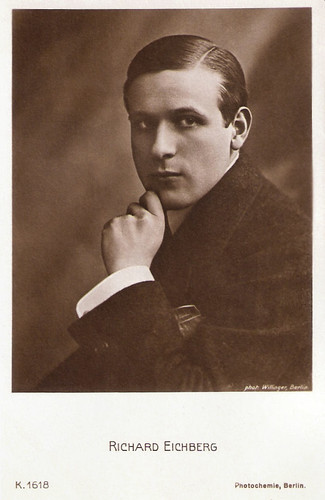Hungarian-born photographer Laszlo Willinger (1909–1989) is most noted for his phenomenal Hollywood star portraits of the 1930s and 1940s. Less known is that Willinger and his mother, photographer Margaret Willinger, also made hundreds of portraits of film actors and other celebrities during the 1920s and 1930s. They were often used for European film star postcards, but which of the Atelier Willinger portraits is made by Margaret and which by Laszlo?

German postcard by Verlag Hermann Leiser, Berlin-Wilm., no. 8556. Photo: Willinger (Margaret Willinger). Maria Carmi in the stage play (1911) or the Austrian-British film Das Mirakel/The Miracle (1912).

Austrian postcard. Photo: Willinger, Wien (Margaret Willinger). Publicity still for the stage production Jedermann with Alexander Moissi as Jedermann and Luis Rainer as Death, staged at the Salzburger Festspiele 1926.

Austrian postcard by Iris Verlag, no. 633. Photo: Willinger (Margaret Willinger). Under the direction of Max Reinhardt, Max Pallenberg played Traffaldino in 'Turandot' (1926) by Giacomo Puccini at the Salzburger Festspiele.

Livio Pavanelli. Austrian postcard by Iris Verlag, no. 744. Photo: Atelier Willinger (Margaret Willinger).

Gustav Fröhlich. German postcard by Ross Verlag, no. 8772/1, 1933-1934. Photo: Willinger, Wien (Laszlo Willinger).
Laszlo Willinger was born in Budapest, Hungary, in 1909. His father owned a news agency, and his mother was a professional photographer. Willinger grew up surrounded by art and photography, as his mother Margarete shared her passion for photography with her son at a very early age.
Laszlo went to Berlin to study photography. At 16, he became a professional photographer when he opened his first studio in Berlin. At 19 he went to Paris, where he managed the portrait studio of the Keystone Agency, also known as the Talbot Studios. In 1931, he established a new studio in Berlin. (The sources differ about which studio he opened where). Later, he said, "When I started out in Germany in the late 1920s, photographers used either daylight or a very diffused light. I never did. I used spots-arcs, which give you a point source of light.”
He worked as a freelance photojournalist for German magazines such as Berliner Illustrierte, Hamburger Illustrierte, and Munchener Illustrierte. His subjects included Josephine Baker, the French President Paul Doumer, Sacha Guitry, and Yvonne Printemps. In 1932, he visited the US on assignment for Mercedes Benz.
Willinger left Germany in 1933 when Adolf Hitler became chancellor. He settled in Vienna where his mother already had a studio, Atelier Weninger. He photographed such celebrities as Sigmund Freud, psychiatrist and psychotherapist Carl Jung, Marlene Dietrich, Hedy Lamarr (then Hedvig Kiesler), and Emil Jannings. He also documented Max Reinhardt’s stage productions.
In 1936 Willinger travelled for Keystone Press Agency through Africa and Asia. His photos were published in the London Daily Express. That year, he was also stationed in Spain during the Civil War. Between 1933 and 1937 he was unable to obtain the necessary working permits for Germany, so any photographs reproduced in German photo annuals during this period were credited to his mother, Margaret Willinger.

Ellen Richter. German postcard by Rotophot., no. 1651. Photo: Willinger (Margaret Willinger).

Albert Bassermann and Else Bassermann. German postcard, no. 8772. Photo: Willinger (Margaret Willinger).

Suzanne Grandais. French postcard, no. 7872. Photo Willinger (Margaret Willinger).

Richard Eichberg. German postcard by Photochemie, Berlin, K. 1618. Photo Willinger, Berlin (Margaret Willinger).

Liane Haid. German postcard by Photochemie, Berlin, no. K. 2377. Photo: Willinger, Wien.
According to Wikipedia and to David Fahey and Linda Rich in their study 'Masters of Starlight', Laszlo Willinger was ‘discovered ‘and invited by studio photographer Eugene Robert Richee to move to the United States.
However, the blog mistress at Iconista cites a source which claims that it was Louis B. Mayer, who was looking for talent for MGM Studios. In Vienna, Mayer signed Willinger, but also Hedy Lamarr and Luise Rainer at the same time as part of the studio’s last European sweep for talent before the outbreak of the Second World War.
In Hollywood Willinger replaced studio photographer Ted Allan at MGM (others say he replaced George Hurrell).
Kendra Bean at her blog Vivandlarry.com: “Willinger brought a fresh look to MGM and Hollywood photography — his prints have a crisp luminescence and his compositions often orient his subjects on the diagonal, which gives them a modern, European sophistication.”
Iconista describes how he worked in Hollywood: “Willinger acted as the art director when photographing the stars. The only thing expected of him was to make images that the press would choose to print over everyone else’s. There could be up to 5000 pictures available on any major star. To get printed, your photograph had to be the best. One thing he always kept in mind, regardless of the subject, is that the photograph has a purpose – and that’s to sell.”

Albert Paulig. German postcard by Photochemie, no. K. 1332. Berlin. Sent by mail in 1917. Photo: Willinger (Margaret Willinger).

Livio Pavanelli. German postcard by Ross Verlag, no. 1598/1, 1927-1928. Photo Willinger, Vienna (Margaret Willinger). Livio Pavanelli in the German silent film Die letzte Einquartierung aka Küssen ist keine Sünd'/Kissing is No Sin (Rudolf Walther-Fein, Rudolf Dworsky, 1926), starring Xenia Desni.

Grete Mosheim. German postcard by Ross Verlag, no. 3204/1, 1928-1929. Photo: Atelier Willinger (Laszlo Willinger).

André Mattoni. German postcard by Ross Verlag, no. 3745/1, 1928-1929. Photo: Atelier Willinger, Berlin (Laszlo Willinger).

Dolly Haas. German postcard by Ross Verlag, no. 7825/1, 1932-1933. Photo: Willinger, Berlin. Dolly Haas in her outfit of Das hässliche Mädchen/The Ugly Girl (Henry Koster/Hermann Kosterlitz, 1933), distributed by Bayerische Film.
In Hollywood, Laszlo Willinger photographed as many as four stars every week, using lighting, costumes and emotion as a film director might. MGM divas Norma Shearer and Joan Crawford wanted Willinger to make their portraits. He photographed Shearer beautifully for Marie Antoinette (1937) and The Women (1939).
Decades later, Willinger said in an interview with author and photo collector John Kobal: “If Shearer liked 10 per cent of a sitting, you were going great. With Crawford, you could figure 80 per cent would be okay.” Willinger considered Crawford, Clark Gable and Vivien Leigh his favourite subjects: “The one I liked best to work with was Vivien Leigh. She was a thorough professional.” His 1940 series of portraits of Olivier and Leigh are housed in the National Portrait Gallery in London.
Willinger was also one of the first Hollywood photographers to experiment with the use of colour. He worked exclusively for MGM until 1944. Later, he spent 40 years at FPG, a New York photo agency that stocked about 50,000 of his photos. Willinger was a frequent contributor to magazines and periodicals, providing magazine cover portraits of the young Marilyn Monroe and other popular stars.
Wikipedia describes how Willinger shortly before his death was accused of stalking some celebrities, including Charlie Chaplin. An investigation into the matter led to the uncovering of thousands of personal pictures of Chaplin.
In 1989, Laszlo Willinger died of heart failure in Los Angeles at age 83 (some sources suggest that he committed suicide because of the investigation). He was survived by his wife Yvonne Willinger. There is no information about what happened to his mother, Margaret Willinger.

Lilian Harvey and Willy Fritsch. Austrian postcard by Iris Verlag, no. 6250. Photo: Willinger and Lechner.

Gustav Fröhlich and Annabella. German postcard by Ross Verlag, no. 7877/2, 1932-1933. Photo: Cinema / Willinger, Wien. Gustav Fröhlich and Annabella in Sonnenstrahl/Two Souls in a Soulless City (Paul Fejos, 1933).

Hans Jaray. German postcard by Ross Verlag, no. 8087/1, 1933-1934. Photo: Willinger, Vienna. Hans Jaray in the Franz Schubert biopic Leise fliehen meine Lieder (Willi Forst, 1933). In 1934 an alternative language version was made in English, also with Jaray: Unfinished Symphony (Willi Forst, Anthony Asquith, 1934).

Lida Baarova and Gustav Fröhlich. German postcard by Ross Verlag, no. 9228/1, 1935-1936. Photo: Willinger, Wien (Laszlo Willinger).

Hedy Lamarr. French postcard by Editions Chantal, no. 10. Photo: MGM (Laszlo Willinger, 1939).
This is the tenth and final post in a series on film star photographers. Earlier posts were on the Reutlinger Studio in Paris, Italian star photographer Attilio Badodi, the German photographer Ernst Schneider, Dutch photo artist Godfried de Groot, Milanese photographers Arturo Varischi and Giovanni Artico, the French Studio Lorelle, the British 'royal' photographer Dorothy Wilding, Berlin duo Becker & Maass and French Lucienne Chevert.
Sources: David Fahey & Linda Rich (Masters of Starlight), Myrna Oliver (Los Angeles Times), Kendra Bean (vivandlarry.com - Now defunct), John Kobal (Movie Star Portraits of the Forties), Iconista, Vintage Movie Star Photos, AP News Archive (Page now defunct), Wikipedia and IMDb.
This post was last updated on 3 January 2025.

German postcard by Verlag Hermann Leiser, Berlin-Wilm., no. 8556. Photo: Willinger (Margaret Willinger). Maria Carmi in the stage play (1911) or the Austrian-British film Das Mirakel/The Miracle (1912).

Austrian postcard. Photo: Willinger, Wien (Margaret Willinger). Publicity still for the stage production Jedermann with Alexander Moissi as Jedermann and Luis Rainer as Death, staged at the Salzburger Festspiele 1926.

Austrian postcard by Iris Verlag, no. 633. Photo: Willinger (Margaret Willinger). Under the direction of Max Reinhardt, Max Pallenberg played Traffaldino in 'Turandot' (1926) by Giacomo Puccini at the Salzburger Festspiele.

Livio Pavanelli. Austrian postcard by Iris Verlag, no. 744. Photo: Atelier Willinger (Margaret Willinger).

Gustav Fröhlich. German postcard by Ross Verlag, no. 8772/1, 1933-1934. Photo: Willinger, Wien (Laszlo Willinger).
Passion for photography
Laszlo Willinger was born in Budapest, Hungary, in 1909. His father owned a news agency, and his mother was a professional photographer. Willinger grew up surrounded by art and photography, as his mother Margarete shared her passion for photography with her son at a very early age.
Laszlo went to Berlin to study photography. At 16, he became a professional photographer when he opened his first studio in Berlin. At 19 he went to Paris, where he managed the portrait studio of the Keystone Agency, also known as the Talbot Studios. In 1931, he established a new studio in Berlin. (The sources differ about which studio he opened where). Later, he said, "When I started out in Germany in the late 1920s, photographers used either daylight or a very diffused light. I never did. I used spots-arcs, which give you a point source of light.”
He worked as a freelance photojournalist for German magazines such as Berliner Illustrierte, Hamburger Illustrierte, and Munchener Illustrierte. His subjects included Josephine Baker, the French President Paul Doumer, Sacha Guitry, and Yvonne Printemps. In 1932, he visited the US on assignment for Mercedes Benz.
Willinger left Germany in 1933 when Adolf Hitler became chancellor. He settled in Vienna where his mother already had a studio, Atelier Weninger. He photographed such celebrities as Sigmund Freud, psychiatrist and psychotherapist Carl Jung, Marlene Dietrich, Hedy Lamarr (then Hedvig Kiesler), and Emil Jannings. He also documented Max Reinhardt’s stage productions.
In 1936 Willinger travelled for Keystone Press Agency through Africa and Asia. His photos were published in the London Daily Express. That year, he was also stationed in Spain during the Civil War. Between 1933 and 1937 he was unable to obtain the necessary working permits for Germany, so any photographs reproduced in German photo annuals during this period were credited to his mother, Margaret Willinger.

Ellen Richter. German postcard by Rotophot., no. 1651. Photo: Willinger (Margaret Willinger).

Albert Bassermann and Else Bassermann. German postcard, no. 8772. Photo: Willinger (Margaret Willinger).

Suzanne Grandais. French postcard, no. 7872. Photo Willinger (Margaret Willinger).

Richard Eichberg. German postcard by Photochemie, Berlin, K. 1618. Photo Willinger, Berlin (Margaret Willinger).

Liane Haid. German postcard by Photochemie, Berlin, no. K. 2377. Photo: Willinger, Wien.
MGM's last sweep for European talent
According to Wikipedia and to David Fahey and Linda Rich in their study 'Masters of Starlight', Laszlo Willinger was ‘discovered ‘and invited by studio photographer Eugene Robert Richee to move to the United States.
However, the blog mistress at Iconista cites a source which claims that it was Louis B. Mayer, who was looking for talent for MGM Studios. In Vienna, Mayer signed Willinger, but also Hedy Lamarr and Luise Rainer at the same time as part of the studio’s last European sweep for talent before the outbreak of the Second World War.
In Hollywood Willinger replaced studio photographer Ted Allan at MGM (others say he replaced George Hurrell).
Kendra Bean at her blog Vivandlarry.com: “Willinger brought a fresh look to MGM and Hollywood photography — his prints have a crisp luminescence and his compositions often orient his subjects on the diagonal, which gives them a modern, European sophistication.”
Iconista describes how he worked in Hollywood: “Willinger acted as the art director when photographing the stars. The only thing expected of him was to make images that the press would choose to print over everyone else’s. There could be up to 5000 pictures available on any major star. To get printed, your photograph had to be the best. One thing he always kept in mind, regardless of the subject, is that the photograph has a purpose – and that’s to sell.”

Albert Paulig. German postcard by Photochemie, no. K. 1332. Berlin. Sent by mail in 1917. Photo: Willinger (Margaret Willinger).

Livio Pavanelli. German postcard by Ross Verlag, no. 1598/1, 1927-1928. Photo Willinger, Vienna (Margaret Willinger). Livio Pavanelli in the German silent film Die letzte Einquartierung aka Küssen ist keine Sünd'/Kissing is No Sin (Rudolf Walther-Fein, Rudolf Dworsky, 1926), starring Xenia Desni.

Grete Mosheim. German postcard by Ross Verlag, no. 3204/1, 1928-1929. Photo: Atelier Willinger (Laszlo Willinger).

André Mattoni. German postcard by Ross Verlag, no. 3745/1, 1928-1929. Photo: Atelier Willinger, Berlin (Laszlo Willinger).

Dolly Haas. German postcard by Ross Verlag, no. 7825/1, 1932-1933. Photo: Willinger, Berlin. Dolly Haas in her outfit of Das hässliche Mädchen/The Ugly Girl (Henry Koster/Hermann Kosterlitz, 1933), distributed by Bayerische Film.
Stalking Chaplin
In Hollywood, Laszlo Willinger photographed as many as four stars every week, using lighting, costumes and emotion as a film director might. MGM divas Norma Shearer and Joan Crawford wanted Willinger to make their portraits. He photographed Shearer beautifully for Marie Antoinette (1937) and The Women (1939).
Decades later, Willinger said in an interview with author and photo collector John Kobal: “If Shearer liked 10 per cent of a sitting, you were going great. With Crawford, you could figure 80 per cent would be okay.” Willinger considered Crawford, Clark Gable and Vivien Leigh his favourite subjects: “The one I liked best to work with was Vivien Leigh. She was a thorough professional.” His 1940 series of portraits of Olivier and Leigh are housed in the National Portrait Gallery in London.
Willinger was also one of the first Hollywood photographers to experiment with the use of colour. He worked exclusively for MGM until 1944. Later, he spent 40 years at FPG, a New York photo agency that stocked about 50,000 of his photos. Willinger was a frequent contributor to magazines and periodicals, providing magazine cover portraits of the young Marilyn Monroe and other popular stars.
Wikipedia describes how Willinger shortly before his death was accused of stalking some celebrities, including Charlie Chaplin. An investigation into the matter led to the uncovering of thousands of personal pictures of Chaplin.
In 1989, Laszlo Willinger died of heart failure in Los Angeles at age 83 (some sources suggest that he committed suicide because of the investigation). He was survived by his wife Yvonne Willinger. There is no information about what happened to his mother, Margaret Willinger.

Lilian Harvey and Willy Fritsch. Austrian postcard by Iris Verlag, no. 6250. Photo: Willinger and Lechner.

Gustav Fröhlich and Annabella. German postcard by Ross Verlag, no. 7877/2, 1932-1933. Photo: Cinema / Willinger, Wien. Gustav Fröhlich and Annabella in Sonnenstrahl/Two Souls in a Soulless City (Paul Fejos, 1933).

Hans Jaray. German postcard by Ross Verlag, no. 8087/1, 1933-1934. Photo: Willinger, Vienna. Hans Jaray in the Franz Schubert biopic Leise fliehen meine Lieder (Willi Forst, 1933). In 1934 an alternative language version was made in English, also with Jaray: Unfinished Symphony (Willi Forst, Anthony Asquith, 1934).

Lida Baarova and Gustav Fröhlich. German postcard by Ross Verlag, no. 9228/1, 1935-1936. Photo: Willinger, Wien (Laszlo Willinger).

Hedy Lamarr. French postcard by Editions Chantal, no. 10. Photo: MGM (Laszlo Willinger, 1939).
This is the tenth and final post in a series on film star photographers. Earlier posts were on the Reutlinger Studio in Paris, Italian star photographer Attilio Badodi, the German photographer Ernst Schneider, Dutch photo artist Godfried de Groot, Milanese photographers Arturo Varischi and Giovanni Artico, the French Studio Lorelle, the British 'royal' photographer Dorothy Wilding, Berlin duo Becker & Maass and French Lucienne Chevert.
Sources: David Fahey & Linda Rich (Masters of Starlight), Myrna Oliver (Los Angeles Times), Kendra Bean (vivandlarry.com - Now defunct), John Kobal (Movie Star Portraits of the Forties), Iconista, Vintage Movie Star Photos, AP News Archive (Page now defunct), Wikipedia and IMDb.
This post was last updated on 3 January 2025.
No comments:
Post a Comment